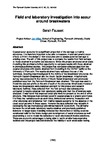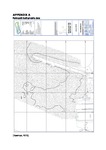Field and laboratory investigation into scour around breakwaters
| dc.contributor.author | Fausset, S. | |
| dc.date.accessioned | 2019-05-20T13:02:50Z | |
| dc.date.available | 2019-05-20T13:02:50Z | |
| dc.date.issued | 2017 | |
| dc.identifier.citation |
Fausset, S. (2017) 'Field and laboratory investigation into scour around breakwaters', The Plymouth Student Scientist, 10(1), p. 195-238. | en_US |
| dc.identifier.issn | 1754-2383 | |
| dc.identifier.uri | http://hdl.handle.net/10026.1/14144 | |
| dc.description.abstract |
Coastal scour accounts for a significant proportion of the damage to marine structures. It is therefore important to be able to measure, model and predict scour effects to inform the design of new structures and to assess potential damage to existing ones. The aim of this project was to compare the results from field surveys to those obtained in a marine test laboratory. Since this project employed small scale modelling this provided a further opportunity to compare results with those obtained in previous published studies. This project has compared collected data from two coastal structures with results obtained from modelling in the COAST facility at the University of Plymouth. The results obtained have validated the use of this technique. Scouring was investigated in the vicinity of two breakwater structures; the Falmouth Eastern breakwater and the Mount Batten breakwater. A bathymetric survey was conducted in the vicinity of Mount Batten breakwater and previously published data from the Falmouth breakwater was obtained. This data was used to model the sea bed profile at the end of each of the structures. Small scale models of these two breakwaters were designed and built for this project and tested in laboratory facilities. Data collected from the field surveys was subsequently compared to results collected from laboratory testing and then the differences were analysed. It was found that expected scour pits were not present at the end of either structure. This indicates how complex scour in coastal areas is to predict and model, it is likely that variables such as such tides, bidirectional currents, interaction with other structures and turbulence from marine vessels accounts for the absence of the usual scour patterns in these cases. However the data collected was valuable in developing the test methodology and will be helpful in future work. The similarity between the small scale laboratory results obtained and previously published literature for larger scale modelling indicates that this method of testing could be considered valid for the future design and development of costal structures as well as providing a tool to model the behaviour of such structures in hostile conditions. There are economic advantages to being able to test in smaller less expensive facilities and this project has demonstrated the validity of such small scale testing. | en_US |
| dc.language.iso | en | en_US |
| dc.publisher | University of Plymouth | |
| dc.rights | Attribution 3.0 United States | * |
| dc.rights.uri | http://creativecommons.org/licenses/by/3.0/us/ | * |
| dc.subject | Coastal scour | en_US |
| dc.subject | marine environment | en_US |
| dc.subject | damage to marine structures. | en_US |
| dc.subject | scour effects | en_US |
| dc.subject | COAST facility | en_US |
| dc.subject | Falmouth breakwater | en_US |
| dc.subject | predict and model | en_US |
| dc.subject | breakwater | en_US |
| dc.title | Field and laboratory investigation into scour around breakwaters | en_US |
| dc.type | Article | |
| plymouth.issue | 1 | |
| plymouth.volume | 10 | |
| plymouth.journal | The Plymouth Student Scientist |




